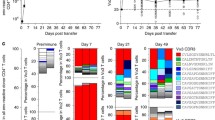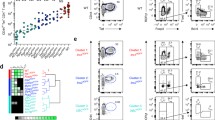Abstract
T lymphocytes recognize the synthetic polypeptides GA and GLT and the natural antigen LDHB and are thereby stimulated to proliferate in vitro. Simultaneously with the antigen, T cells recognize class II MHC molecules of the antigen-presenting cell and the T-cell proliferation can therefore be inhibited by the addition of monoclonal antibodies specific for either A (AαA β ) or E (EαF β ) molecules. Antibody blocking of in vitro responses thus provides an opportunity to test the rules governing the selection of class II molecules (A versus E) in the recognition of different antigens. To determine these rules we tested T cells for some 40 strains (classical inbred strains and B10.W lines) carrying H-2 haplotypes derived from wild mice) for their proliferative response to GA, GLT, and LDHB. Strains that responded were then tested in the antibody-blocking assay to determine the class II context of the response. The response to GA occurred always in the context of the A molecule; no single instance was found of the response being channelled through the E molecule. Of the 19 different A molecules (A allomorphs) that could be tested, nine (47 percent) were able to provide the context for GA recognition (and hence conferred responsiveness), while the rest failed to do so (conferred nonresponsiveness). Of the 17 informative cases tested for the response to LDHB, 14 channelled the response through the A molecule, while, in the remaining cases, the cells failed to respond altogether. And again, there was no case where the response was channelled through the E molecule. However, in two instances (of 14) the E molecule provided the context for the stimulation of suppressor T cells, which then suppressed the response of helper T cells occurring in the context of the A molecule. Of the 19 cases tested for the response to GLT, eight channelled the response through the E molecule and two through the A molecule. The two cases of an E → A switch were those in which the strains failed to express cell-surface E molecules as a result of a mutation in one of the E-encoding loci. These data indicate a remarkable but puzzling consistency in the channelling of the response to a given antigen via either A or E molecules. This consistency may be a hint that there is a link between the specificity of antigen (nonself) and MHC (self) recognition by T lymphocytes.
Similar content being viewed by others
Abbreviations
- APC:
-
antigen-presenting cell
- GA:
-
poly (Glu40Ala60)
- GLT:
-
poly (Glu51Lys34Tyr15)
- Ir:
-
immune response
- LDHB :
-
lactate dehydrogenase 134
- MHC:
-
major histocompatibility complex
- TH :
-
T helper (cell)
- TS :
-
T suppressor (cell)
References
Alkan, S. S.: Antigen-induced proliferation assay for mouse T lymphocytes. Response to a monovalent antigen. Eur. J. Immunol. 8: 112–118, 1978
Baxevanis, C. N., Wernet, D., Nagy, Z. A., Maurer, P. H., and Klein, J.: Genetic control of T-cell proliferative responses to poly (glu40ala60) and poly (glu51lys34tyr15): Subregion-specific inhibition of the responses with monoclonal Ia antibodies. Immunogenetics 11: 617–628, 1980
Baxevanis, C. N., Nagy, Z. A., and Klein, J.: A novel type of T-T cell interaction removes the requirement for I-B region in the H-2 complex. Proc. Natl. Acad. Sci. U.S.A. 78: 3809–3813, 1981
Benacerraf, B. and McDevitt, H. O.: Histocompatibility-linked immune response genes. Science 175: 273–279, 1972
Corradin, G., Etlinger, H. M., and Chiller, J. M.: Lymphocyte specificity to protein antigens. I. Characterization of the antigen-induced in vitro T cell-dependent proliferative response with lymph node cells from primed mice. J. Immunol. 119: 1048–1053, 1977
Fachet, J. and Andó, I.: Genetic control of contact sensitivity to oxazolone in inbred, H-2 congenic and intra-H-2 recombinant strains of mice. Eur. J. Immunol. 7: 223–226, 1977
Jones, P. P., Murphy, D. B., and McDevitt, H. O.: Two-gene control of the expression of murine Ia antigen. J. Exp. Med. 148: 925–933, 1978
Ishii, N., Baxevanis, C. N., Nagy, Z. A., and Klein, J.: Responder T cells depleted of alloreactive cells react to antigen presented on allogeneic macrophages from nonresponder strains. J. Exp. Med., in press, 1981
Katz, D. H.: Lymphocyte Differentiation, Recognition and Regulation. Academic Press, New York, San Francisco, London, 1977
Klein, J., Chiang, C. L., and Wakeland, E. K.: Histocompatibility antigens controlled by the I region of the murine H-2 complex. III. Blocking with antisera of the in vitro response. Immunogenetics 5: 445–451, 1977
Klein, J.: Generation of diversity at MHC loci: implications for T cell receptor repertoires. In M. Fougereau and J. Dausset (eds.): Immunology 80, pp. 239–253, Academic Press, London, 1980
Klein, J. and Figueroa, F.: Polymorphism of the mouse H-2 loci. Immunol. Rev., in press, 1981
Lemke, H., Hämmerling, G. J., and Hämmerling, U.: Fine specificity analysis with monoclonal antibodies of antigens controlled by the major histocompatibility complex and by the Qa/TL region in mice. Immunol. Rev. 47: 175–206, 1979
Lieberman, R., Paul, W. E., Humphrey, Jr., W., and Stimpfling, J. H.: H-2-linked immune response (Ir) genes. Independent loci for Ir-IgG and Ir-IgA genes. J. Exp. Med. 136: 1231–1240, 1972
Melchers, I., Rajewsky, K., and Shreffler, D. C.: Ir-LDHB: map position and functional analysis. Eur. J. Immunol. 3: 754–761, 1973
Nagy, Z. A., Baxevanis, C. N., Ishii, N., and Klein, J.: la antigens as restriction molecules in Ir-gene controlled T-cell proliferation. Immunol. Rev. in press, 1981
Oi, V. T., Jones, P. P., Goding, J. W., Herzenberg, L. A., and Herzenberg, L. A.: Properties of monoclonal antibodies to mouse Ig allotypes, H-2, and Ia antigens. Curr. Top. Microbiol. Immunol. 81: 115–129, 1978
Schwartz, R. H., Jackson, L., and Paul, W. E.: T lymphocyte-enriched murine peritoneal exudate cells. I. A reliable assay for antigen-induced T lymphocyte proliferation. J. Immunol. 115: 1330–1338, 1975
Schwartz, R. H. and Paul, W. E.: T-lymphocyte-enriched murine peritoneal exudate cells. II. Genetic control of antigen-induced T lymphocyte proliferation. J. Exp. Med. 143: 529–540, 1976
Sela, M.: Antigenicity: some molecular aspects. Science 166: 1365–1374, 1969
Uhr, J. W., Capra, J. D., Vitetta, E. S., and Cook, R. G.: Organization of the immune response genes. Both subunits of murine I-A and I-E/C molecules are encoded within the I-region. Science 206: 292–297, 1979
Vollmers, H. P., Eulitz, M., and Götze, D.: Reactivity of hybridoma antibodies specific for H-2 antigens with cells of inbred and wild mice. Immunogenetics 8: 447–459, 1979
Author information
Authors and Affiliations
Rights and permissions
About this article
Cite this article
Ishii, N., Baxevanis, C.N., Nagy, Z.A. et al. Selection of H-2 molecules for the context of antigen recognition by T lymphocytes. Immunogenetics 14, 283–292 (1981). https://doi.org/10.1007/BF00342197
Issue Date:
DOI: https://doi.org/10.1007/BF00342197




